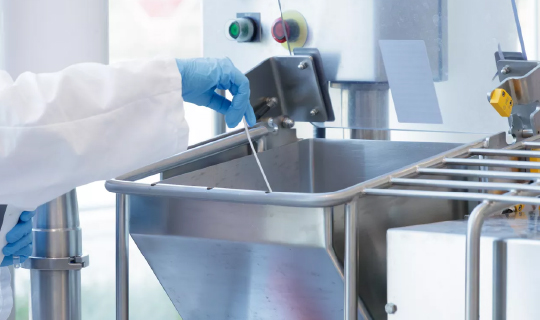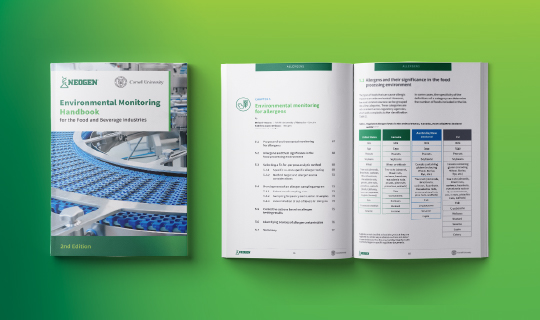Environmental Monitoring for Food Allergens
11월 03, 2025

Food allergies are on the rise. Recent studies show they affect an estimated 10% of the U.S. population, including up to 8% of infants and young children (Gupta et al., Pediatrics, 2018), with reactions ranging from severe to life-threatening. As cases continue to rise, facilities that work with allergen-containing products will find it more important than ever to strengthen their Environmental Monitoring Program (EMP) to help prevent accidental exposure.

Environmental monitoring is a key part of any food safety system and helps teams detect allergens early, confirm cleaning effectiveness, and prevent cross-contact.
For helpful guidance on how to create and implement a robust allergen monitoring program for your facility, Neogen offers an Environmental Monitoring Handbook for the Food and Beverage Industries (2nd Edition, 2025). Here are some important takeaways from the chapter on allergens to help you get started.
Why Allergen Monitoring Matters
Undeclared allergens are still among the leading causes of food recalls in the United States. Without a strong EMP, facilities that work with allergenic-containing products may risk costly recalls, potential safety issues, and losing customer trust.
Environmental monitoring helps reduce these risks by validating and verifying that your cleaning protocols work, and your production environment stays under control. If your facility switches between allergen-containing and allergen-free product lines, strong monitoring is essential. For example, if you produce chocolate bars with peanuts followed by a peanut-free batch, your EMP must validate the removal of peanut proteins to protect customers and prevent recalls due to undeclared allergens.
An effective allergen EMP also strengthens your facility’s Hazard Analysis and Critical Control Points (HACCP) plan and aligns with the Food Safety Modernization Act (FSMA) and Global Food Safety Initiative (GFSI).
The Food Safety Modernization Act (FSMA) requires manufacturers in the United States and those that export food to the United States to include allergen controls in their food safety plan. The Global Food Safety Initiative (GFSI) also requires allergen controls to be identified and monitored.
Integrating allergen monitoring into a robust EMP reinforces compliance, verifies sanitation steps, and protects your customers. To build an effective plan, you need to understand where allergens may enter your facility, and the specific risks involved. Recognizing these vulnerabilities allows you to establish proactive control measures that help keep your products safe.
Understanding Allergen Risks in Your Facility
Identifying sources of allergen contamination begins with understanding your products and how processing impacts them within your facility. Some allergens such as milk, eggs, peanuts, and other raw ingredients pose obvious risks. However, your food processing can introduce less obvious or entirely new risks that your team needs to identify and control. For example, baking, fermentation, and processes that break protein into small peptides can make allergenic ingredients undetectable. In other cases, allergenic ingredients are intentionally modified through processing yet still retain their allergenic potential. These processing quirks complicate allergen tracking and control.
Adding to the challenge, facilities must often navigate mislabeled sourced products or varying regulatory requirements, such as different threshold limits—the minimum amount of an allergen that can trigger a reaction in sensitive individuals.
These variables emphasize the need for proactive monitoring and a strong understanding of your facility’s specific risks, starting with how you process, handle, and source each product. By recognizing your facility’s specific quirks and challenges and accounting for them in the EMP, your food safety team can gain better allergen control within your facility.
Understanding your facility’s unique risks sets the stage for effective allergen control. The next step is selecting targeted sampling strategies that match your facility’s specific needs.
How to Get Started: Sampling and Frequency

Once your team understands the risks, the next step is selecting the right sampling strategy to support your allergen control monitoring program. Allergen-specific detection sampling methods like ELISA (enzyme-linked immunosorbent assay) and LFD (lateral flow devices) identify and/or quantify specific allergenic proteins.
These tests are ideal for verifying the removal of known allergens such as peanut, soy, and gluten.
For broader screening of cleaning effectiveness, non- specific protein tests can be valuable. These include protein swabs and ATP (adenosine triphosphate) tests. Because of their sensitivity, protein swabs offer a more direct assessment of the success in removing allergenic proteins from surfaces, but do not identify specific allergens. ATP testing, often used as a general hygiene indicator, measures organic residue levels. Low ATP levels may suggest effective cleaning, but they do not confirm allergen removal. Certain proteins like egg whites, may still be present even when ATP levels are low.
To optimize your sampling efforts, prioritize high-risk areas such as food-contact surfaces in Zones 1 and 2. Next, consider your facility’s production flow, ingredient use, and historical data to refine your sampling strategy. Elements like production schedules, changeovers, allergen types, and past results should inform your sampling frequency.
Selecting the right sampling methods, zones, and frequency while staying consistent helps you build historical data, track patterns, and spot issues early. But sampling is just the first step. The real value comes when you dig into the results, spot potential risks, and make adjustments to keep your facility protected.
Learn More About Neogen Allergen Tests
What’s Next: Trends and Corrective Action
Once your monitoring program is in place, you can start collecting and documenting results consistently. Tracking both positive and negative findings over time helps you differentiate one-off incidents from ongoing issues, making it easier to catch sanitation, training, or equipment issues. When positive results come up, reclean and retest right away. For higher-risk findings, you may decide to hold production until follow-up testing confirms that the line is clear. In some cases, you may increase monitoring or schedule deep cleaning for medium-risk areas, while prioritizing low-risk areas for future maintenance.
If repeated positives emerge, dig deeper to understand the root cause. Sometimes, issues like equipment design flaws, missed cleaning schedules, or gaps in hygiene practices can cause these problems. When that happens, consider long-term fixes like adjusting how often you clean, revalidating your procedures, or even upgrading equipment to keep your allergen control strategy strong. Documenting each step ensures traceability and helps your facility comply with FSMA and GFSI requirements.
By identifying trends and addressing issues quickly, you help keep your facility safe and compliant. Now, it’s your turn to put that strategy into action with a proactive allergen monitoring plan.
It’s Time to Act
A proactive allergen monitoring strategy helps you prevent contamination, maintain compliance, and protect your brand. By understanding your facility’s specific risks and using the right tools, you can build a stronger, safer food safety system.
Tracking trends over time and responding swiftly to positive results keeps your EMP effective as your production environment evolves. Integrating allergen monitoring into your broader food safety plan also reinforces compliance with FSMA and GFSI standards,
ensuring your facility meets regulatory and certification requirements.
This article is just the beginning. For step-by-step guidance on site selection, sampling methods, and aligning with FSMA and GFSI standards, download Neogen’s Environmental Monitoring Handbook for the Food and Beverage Industries (2nd Edition, 2025).

범주: 식품 안전, 알레젠, 환경 모니터링, Veratox®